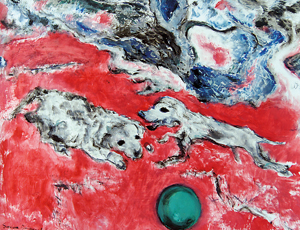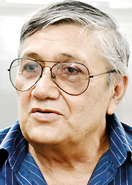The magic still unfolds
A lofty wooden door leads into a well-lit living room, as rays of sunlight peek through a tiny latch in the roof, watching the master at work. An easel placed right under the latch holds an unfinished painting of a house by a lake. This is where Ifthikar Cader works his magic.

Well known for his ‘plein air’ pieces, Ifthikar has successfully captured the essence of the scenic beauty of the country throughout the years, on his long journeys. Now moving into his late 70’s, the journeys don’t come aplenty, but inspiration is never lacking as he sets to work in his sunbathed living room. “I don’t get to enjoy the outdoors as much, and this is quite disheartening as the outdoors fuelled my creations.
But there’s much to enjoy in the simple things that surround you,” he adds with an undying optimism.
The love for painting was something Ifthikar Cader picked up from his elder brother Ashroff, during their younger years. “My brother was adept at water-colour paintings and I used to admire his work,” he recalls. This pushed Ifthikar to try his hand at it himself and to his surprise the paintbrush fitted in his fingertips like a wand to a magician.
He began painting by the time he was 16. Oil paintings have ever since been his forte. “I painted several for my own joy and pleasure and derived great satisfaction when family and friends wanted to keep them in their homes,” he recalls. The only painting from that time still in his possession is a plein air canvas in oils depicting the panoramic view of the Kandy Lake from the magistrate’s bungalow. Completed in 1954, Ifthikar himself is amused at how intact the painting is. “One of the stronger points of oil paintings over the rest is its durability, but I am clearly stunned at how one of my very first forays into art has stood the test of time,” he says.
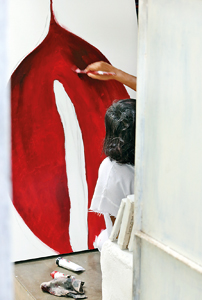 |
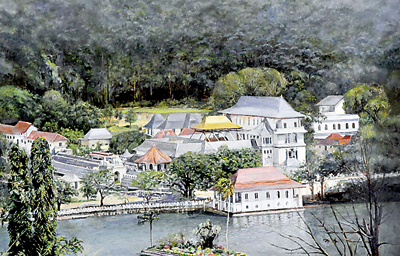 |
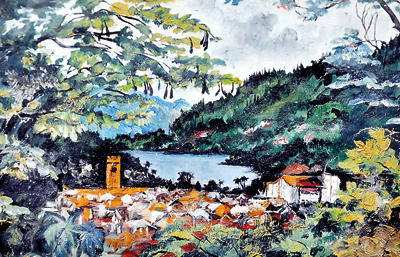 |
In 1959 Ifthikar found himself boarding a plane to the UK upon selection to the prestigious London School of Economics (LSE). “I don’t know if this was the right thing to do, you see. I was still heavily bent on my passion for art,” he confesses. “But art was frowned upon in the country, being an artist was considered the next in line to being a nobody. Society urged us to follow better paths.”
Higher education in the UK proved to be a mixed-bag for him. Painting took a nose-dive, but on the other hand it gave him the rare opportunity of visiting the birthplaces of great art. “I was lucky enough to visit museums such as the National Gallery, and the Tate Gallery and this was pure inspiration to the artist within me.” The high-point, was of course, his visits to the Louvre in Paris, he says.
In his free time in college he would go out and paint scenes on location where he lived in Chiswick. Much of his influences were derived from the work of the post-Impressionists, Manet, Monet, and Pissarro. “Post-Impressionists symbolized an era of freedom. Artists drifted away from mundane paintings,” he states. He is a great fan of post-Impressionist realism, with an ardent passion for bringing out the reality in the things we see.
Completing his degree, Ifthikar met a Sri Lankan jeweller on his visits abroad, and ventured into the gem industry, spending the next 20 years in the trade. He found love on a visit to Pakistan where he set eyes on his wife to be, Shamimara.
It was late 1993 when his business was at a low ebb that an innocent plea from his daughter triggered a change of fortune. “Why don’t you start painting again, my daughter asked me, and it really hit me,” he says. Ifthikar picked up the paintbrush a second time, and this time he was determined to stay faithful to art. “God does things in mysterious ways,” he smiles.
Plein-air , French for ‘open air’, was the art form that Ifthikar took up. Plein air painting is where the artist has to capture the essence of the scene, quickly, before the light changes and affects colours in both shadowed and light areas. “I take photographs of the subject and quickly sketch the outlines of the main shapes with a weak texture,” he explains, later moving on to block the tonal values before painting the shapes wet with local colours. “I then quickly paint in the details of the form and finally the highlights.”
A self-taught artist, Ifthikar’s first exhibition in 1996 at the Lionel Wendt was a huge success. He has spent 16 years since indulging in his most beloved passion, and nothing has kept him more happy.
A collection of 50 of Ifthikar Cader’s oil paintings will be on display at his latest exhibition, ‘In the tradition of plein air realism’ to be held at the Harold Peiris Gallery, from 10 a.m. to 7.30 p.m. on December 8 and 9.
Follow @timesonlinelk
comments powered by Disqus
























